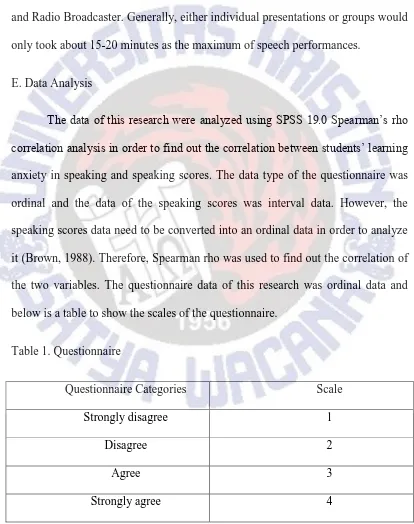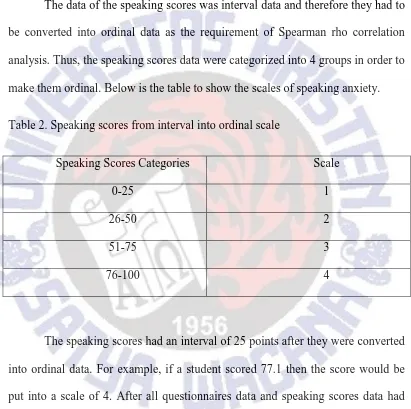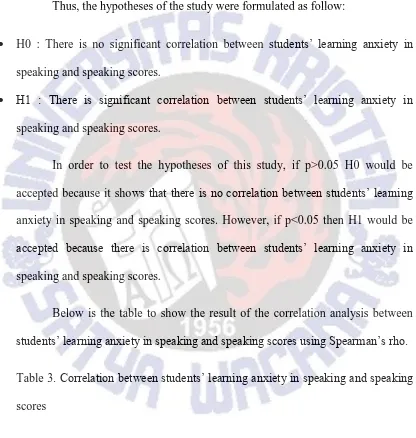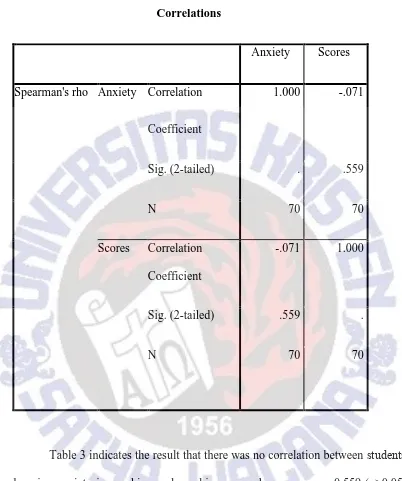CORRELATION BETWEEN STUDENTS’ LANGUAGE
LEARNING ANXIETY AND THEIR SCORES IN SPEAKING
CLASS
THESIS
Submitted in Partial Fulfillment of the Requirements for the Degree of
Sarjana Pendidikan
Savira Putri Mayasari 112005072
ENGLISH DEPARTMENT
FACULTY OF LANGUAGE AND LITERATURE
SATYA WACANA CHRISTIAN UNIVERSITY
CORRELATION BETWEEN STUDENTS’ LANGUAGE
LEARNING ANXIETY AND THEIR SCORES IN SPEAKING
CLASS
THESIS
Submitted in Partial Fulfillment of the Requirements for the Degree of
Sarjana Pendidikan
Savira Putri Mayasari 112005072
ENGLISH DEPARTMENT
FACULTY OF LANGUAGE AND LITERATURE
SATYA WACANA CHRISTIAN UNIVERSITY
CORRELATION BETWEEN STUDENTS’ LANG
UAGE
LEARNING ANXIETY AND THEIR SCORES IN SPEAKING
CLASS
THESIS
Submitted in Partial Fulfillment of the Requirements for the Degree of
Sarjana Pendidikan
Savira Putri Mayasari 112005072
Approved by:
Prof. DR. Gusti Astika, M.A. Hendro Setiawan H., M. A.
COPYRIGHT STATEMENT
This thesis contains no such materials as has been submitted for examination in any course or accepted for the fulfillment of any degree or diploma in any university. To the best of my knowledge and my belief, this contains no material previously published or written by any other person except where due reference is made in the text.
Copyright@2013. Savira Putri Mayasari and Prof. DR. Gusti Astika, M.A.
All rights reserved. No part of this thesis may be reproduced by any means without the permission of at least one of the copyright owners or the English Department, Faculty of Language and Literature, Satya Wacana University, Salatiga.
PUBLICATION AGREEMENT DECLARATION
__________________________________________________________________
As a member of the (SWCU) Satya Wacana Christian University academic community, royalty free right for my intellectual property and contents therein entitled:
CORRELATION BETWEEN STUDENTS’ LANGUAGE LEARNING ANXIETY AND THEIR SCORES IN SPEAKING CLASS
along with my pertinent equipment.
With this non-exclusive royalty free right, SWCU maintains the right to copy, reproduce, print, publish, post, display, incorporate, store in or scan into a retrieval system or database, transmit, broadcast, barter or sell my intellectual property, in whole or in part without my express written permission, as long as my name is still included as the writer.
CORRELATION BETWEEN STUDENTS’ LANGUAGE LEARNING ANXIETY AND THEIR SCORES IN SPEAKING CLASS
Abstract
The purpose of the present study was to find out whether there was any correlation between students’ language learning anxiety and their scores in speaking class. The participants of this research were 70 students of English Department of Satya Wacana Christian University who were taking Speaking course. The students were asked to fill the questionnaires about speaking anxiety. The questionnaire was adopted from Foreign Language Classroom Anxiety Scale (FLCAS) developed by Horwitz (1986).The data of the research were also taken from the students’ final scores in the speaking course. The result of the study shows that there was no correlation between students’ language learning anxiety and their scores in speaking class.
Keywords: correlation, anxiety, speaking performance
Introduction
Speaking is one of the four major skills that students should master in English language learning. As an ESL/EFL learner, the student should be able to speak English in every condition. In English language teaching and learning process, speaking is one of the most important subject for students to cope with because it examines oral production. Unfortunately, there are some problems which occurred especially in the performance goals on Target Language (TL). For example, teachers deal with students who have difficulties to speak fluently when they feel anxious in performing the target language (TL).
an important factor to consider in assessing speaking. As the result, people might easily judge the speakers’ performance as they use a good pronunciation or not. In
other words, Bryant and Wallace (1974) mentioned three kinds of responses when someone deliver a speech, such as the knowledge and understanding, opinions or attitudes, and action of one kind or another by the listeners. In addition to that, Harmer (2001) noted down that there are two major aspects in speaking which are accuracy and fluency, in which learners should consider their correct use of vocabulary, grammar and pronunciation; and fluency. Thus, the inability to pronounce words correctly or use correct grammar can lead to negative evaluation by others that might lead to a confusion and embarrassment by the speakers (Horwitz &Young, 1991). Furthermore, Bygate (1987) mentioned that language teaching, learning, and testing process in speaking L2 has its own right and that oral L2 performance had identified the accuracy and fluency in which learners communicative performance can be influenced through communication practice.
Furthermore, Bygate (1987) points out that there are two aspects by the context of speaking skills which is production and interaction skills. Productions skills are related with making the oral production easier and sound naturally. This skill is connected with the knowledge of the learners in producing the language in different situations. Interaction skills, on the other hand, relates with the routines and negotiation skills. For example, when there are many participants involve in it such as in doctor-patient, teacher-pupil, professor-student, examiner-examinee, parent-children, and adult-child interactions.
To master speaking skill in English language learning, the students should consider those aspects discussed above as their asset to succeed in performing the target language (TL). However, there is one common obstacle for L2 learners due to their performance grades, that is anxiety in language learning. Language anxiety according to Horwitz, Horwitz, and Cope (1986) is defined as “the subjective feeling of tension, apprehension, nervousness, and worry associated with an arousal of the autonomic nervous system” (p.125). For example, language anxiety might lead students to their disabilities to express their ideas and opinions during their performances in target language. As the result, it can affect their grades. Furthermore, Horwitz, Horwitz, and Cope (1986) also stated that anxiety can undermine self-esteem and threaten one self-image. In accordance to that, it becomes one of a problems expressed by ESL/EFL learners in their speaking class.
investigated the factors that caused language anxiety for ESL/EFL learners in learning speaking skills and the influence on communication in the target language. His result indicate that the most anxiety provoking skill in L2 learning was speaking skill. Another study also done by Williams and Andrade, (2008) in Japanese EFL university classes that contained causes, coping, and locus of control foreign language learning anxiety. The findings indicated that anxiety was often associated with the output and processing stages of the learning process and that students attributed the cause of anxiety to the teacher or other people. A study by Kondo and Ying-Ling, (2004) examined about strategies for coping with language anxiety in the case of students of English in Japan. The findings suggested 70 basic tactics for coping with language anxiety that cohered into five strategies: preparation, relaxation, positive thinking, peer seeking, and resignation.
Anyadubalu, (2010) also studied self-efficacy, anxiety, and performance in the English Language among Middle-School Students in English Language Program in Bangkok. The study concluded that English language anxiety and general self-efficacy were significant predictors of English language performance among middle-school students in Satri Si Suriyothai School.
communication apprehension, test anxiety, and fear of negative evaluation. Communication apprehension occurs when people are easier to get anxious in a public speaking or even in a small group. Meanwhile, test anxiety and fear of negative evaluation are dealing with the final scores since anxious students would evaluate others negatively. Thus, language learning anxieties concern on the poor test performance results and might lead to inaccurate grading by the teachers. Based on the recent studies above, it has been proven that there is relationship between language learning anxiety and L2 learners’ performances on target
language (TL).
In addition to that, some previous research also found several effects of anxiety on language learning. Kleinmann, (1977) found that ESL students with high level of anxiety attemped different types of grammar constructions than did less anxious ESL students. Besides, learners also dealing with clinical experience as Horwitz, Horwitz, & Cope, (1986) mentioned that the learners might deal with such experiences such as apprehension, worry, even dread, and moreover they have difficulty concentrating, become forgetful, sweat, and have palpitations.
Since language learning anxiety could influence student’s performance goal on target language (TL), it gives enough reason for this study to investigate the correlation between anxieties with their performances on the target language. This study believes that every student who deals with language learning anxiety might have unsatisfying result of his or her achievement.
anxious before their performance in speaking class. Still, this study is also aimed at finding out whether there is any significant correlation between students’ learning anxiety and their performance scores in Speaking class. Additionally, later on we might expect that this study will bring advantages for teachers and students in English Department of Satya Wacana Christian University. Hopefully, it will help teachers in evaluating students’ performances and also help students to
improve their performances. Thus, the research question that followed this study is “Is there any significant correlation between the student’s anxiety and their
experienced in learning English. This study used a correlational research in order to answer the research question. This study analyzed the correlation between students’ learning anxiety and their test scores in Speaking classes.
B. Participants
class students’ were trained to develop their communication skills especially speaking in front of the class or in the daily conversations.
C. Data of the study
In this research, the first set of data was collected from the questionnaires about language learning anxiety levels. The questionnaire had 10 questions where the items were adopted from Foreign Language Classroom Anxiety Scale (FLCAS) developed by Horwitz (1986). The questionnaires used 4 Likert scale items (1 = strongly disagree, 2 = disagree, 3 = agree, and 4 = strongly agree). The other set of data for this research was speaking scores of Transactional Speaking of group A, B, C, E, and G, obtained from the speaking teachers at the end of the semester.
D. Data Collection
The first step was administering the questionnaires to the students outside the class after they finished their speaking class. Then, the students were asked to put circle of their answer choices; 1 (strongly agree), 2 (disagree), 3 (agree), or 4 (strongly disagree).
There were 14 meetings in this Transactional speaking courses and the presentations were taken individually or in groups. Individual presentations in this course were about Personal Opinions, Interviews and Reports. The group presentations were about Current Affairs, Advertising, Campaign, TV Talk Show, and Radio Broadcaster. Generally, either individual presentations or groups would only took about 15-20 minutes as the maximum of speech performances.
E. Data Analysis
The data of this research were analyzed using SPSS 19.0 Spearman’s rho
correlation analysis in order to find out the correlation between students’ learning
anxiety in speaking and speaking scores. The data type of the questionnaire was ordinal and the data of the speaking scores was interval data. However, the speaking scores data need to be converted into an ordinal data in order to analyze it (Brown, 1988). Therefore, Spearman rho was used to find out the correlation of the two variables. The questionnaire data of this research was ordinal data and below is a table to show the scales of the questionnaire.
Table 1. Questionnaire
Questionnaire Categories Scale
Strongly disagree 1
Disagree 2
Agree 3
The questionnaire data was calculated based on the scales to get the average score from each student (Appendix A). After getting the average score for each student then the correlation analysis was carried out.
The data of the speaking scores was interval data and therefore they had to be converted into ordinal data as the requirement of Spearman rho correlation analysis. Thus, the speaking scores data were categorized into 4 groups in order to make them ordinal. Below is the table to show the scales of speaking anxiety.
Table 2. Speaking scores from interval into ordinal scale
Speaking Scores Categories Scale
0-25 1
26-50 2
51-75 3
76-100 4
The speaking scores had an interval of 25 points after they were converted into ordinal data. For example, if a student scored 77.1 then the score would be put into a scale of 4. After all questionnaires data and speaking scores data had same ordinal scales, then it was analyzed using Spearman rho correlation analysis.
Result and Discussion
questionnaire and ordinal data of speaking final scores, the result of conversion from interval data (Appendix B). They were correlated using Spearman’s rho correlation analysis.
Thus, the hypotheses of the study were formulated as follow:
H0 : There is no significant correlation between students’ learning anxiety in
speaking and speaking scores.
H1 : There is significant correlation between students’ learning anxiety in
speaking and speaking scores.
In order to test the hypotheses of this study, if p>0.05 H0 would be accepted because it shows that there is no correlation between students’ learning anxiety in speaking and speaking scores. However, if p<0.05 then H1 would be accepted because there is correlation between students’ learning anxiety in
speaking and speaking scores.
Below is the table to show the result of the correlation analysis between students’ learning anxiety in speaking and speaking scores using Spearman’s rho.
Correlations
Anxiety Scores
Spearman's rho Anxiety Correlation
Coefficient
1.000 -.071
Sig. (2-tailed) . .559
N 70 70
Scores Correlation Coefficient
-.071 1.000
Sig. (2-tailed) .559 .
N 70 70
Table 3 indicates the result that there was no correlation between students’ learning anxiety in speaking and speaking scores because p was 0.559 (p>0.05). Therefore, H0 was accepted and H1 was rejected.
Conclusion
order to answer this question, Spearman’s rho correlation analysis was used with
SPSS 19.0.
However, as it is shown in Table 3, the correlation coefficient between learning anxiety in speaking and speaking scores was -.071, which means that those two variables did not correlate significantly. In other words, this study did not find statistically significant difference between anxiety and the students’
speaking performance results. This result is not in line with Horwitz et al. (1986) who found that communication apprehension, test anxiety, and fear of negative evaluation effected students’ achievement. In addition to that, past researchers also concluded that there were significant relationship between language performance and English language anxiety and most of them found that students’ with high level of anxiety normally failed in their speech performance (Kleinman, 1977; Horwitz, Horwitz, & Cope, 1986).
This study found out that there was no significant correlation between these two variables. This finding accorded with MacIntrye and Gardner theory (1991) who proposed that anxiety was a general problem which is not spesific to foreign language learning.
Acknowledgement
I want to express my gratitude to Father in heaven, Jesus Christ as my Savior who always gives His blessings and strengthens me in finishing my study. I want to give my special thanks to Prof. Dr. Gusti Astika, M.A. as my supervisor who read my draft, guided me patiently, revised my study, gave me valuable suggestions, and encouraged me to finish my study.
References
Aida, Y. (1994). Examination of Horwitz, Horwitz, and Cope's construct of foreign language anxiety: The case of students of Japanese. The Modern Language Journal, 78, ii 155-168.
Anyadubalu, C. C. (2010). Self-Efficacy, Anxiety, Performance in the English Language among Middle-School Students in English Language Program in Satri Si Suriyothai School, Bangkok. International Journal of Human and Social Sciences 5:3
Brown, J. D. (1988). Understanding Research in Second Language Learning. Cambridge: Cambridge University Press.
Bygate, M. (1987). Teaching English to Speakers of Other Languages. Cambridge: Cambridge University Press.
Horwitz, E. K. (2001). Language Anxiety and Achievement. Annual Review of Applied Linguistics, Vol. 21, pp. 112-126.
Horwitz, E. K., Horwitz, M. B., & Cope, J. (1986). Foreign language classroom anxiety. The Modern Language Journal, 70, 125-132.
Horwitz, E. K. (1991). Preliminary evidence for the reliability and validity of a foreign language anxiety scale. In E. K. Horwitz & D. J. Young (Eds.), Language anxiety: From theory and research to classroom implications
Keramida, A. (2009). Helping Students Overcome Foreign Language Speaking Anxiety in the English Classroom: Theoretical Issues and Practical
Recommendations. Greek Open University.
Kleinmann, H. H. (1977). Avoidance Behavior in Adult Second Language Learning. 27, p. 93-101. TESOL Quarterly (in press).
Koba, N. ,Ogawa, N. , & Wilkinson, D. (2000). Using Community Language Learning Approach to Cope with Language Anxiety. Internet TESL Journal, VI : 11.
Kondo, D.S, & Ling, Y.Y. (2004). Strategies for coping with language anxiety: the case of students of English in Japan. ELT Journal Volume 58/3, 258-265.
Luoma, S. (2004). Assessing Speaking. Cambridge Language Assessment Series: Cambridge University Press, Chapter 2 (pp. 9-28).
Scovel, T. (2001). Teaching English to Speakers of Other Languages. Cambridge University Press: Chapter 11, 80-86.
Tanveer, M. (2007). Investigation of the factors that cause language anxiety for ESL/EFL learners in learning speaking skills and the influence it casts on
communication in the target language. Dissertation, University of
Williams, K. E., Andrade, M. R. (2008).Foreign Language Learning Anxiety in Japanese EFL University Classes: Causes, Coping, and Locus of Control. Electronic Journal of Foreign Language Teaching 2008, Vol. 5, No. 2, pp.
181-191.
APPENDIX A
Language Speaking Anxiety Questionnaire
Name _____________________________ Age __________ Gender(circle one): M / F
Directions: Circle the number that corresponds to your degree of agreement with the statement listed on the left (strongly agree= 4; agree = 3; disagree = 2; strongly disagree = 1)
1. I never feel sure of myself when I have to speak in front of my Speaking class.
4. I keep thinking that the other students are better than I am.
4 3 2 1
5. I start to panic when I have to speak without preparation in my speaking class.
4 3 2 1
6. Even I have a well preparation before my speech, I easily forget things I know in my speaking presentations.
4 3 2 1
7. I feel confident when I have to present my speech in front of the class.
4 3 2 1
8. I always making a good preparation for my speaking presentations.
4 3 2 1
9. I am afraid that my friends will laugh at me when I start my speech.
4 3 2 1
10.I worry if I fail in my Speaking class.
APPENDIX B
Scores of Language Learning Anxiety and Final Grade



